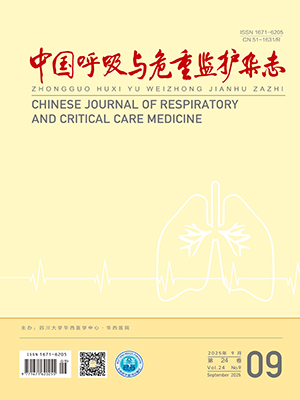| 1. |
Wen YQ, Zhan XJ, Wang NS, et al. Monocyte/lymphocyte ratio and cardiovascular disease mortality in peritoneal dialysis patients. Mediators Inflamm, 2020, 2020: 9852507.
|
| 2. |
Cai JJ, Wang K, Han T, et al. Evaluation of prognostic values of inflammation-based makers in patients with HBV-related acute-on-chronic liver failure. Medicine, 2018, 97(46): 13-24.
|
| 3. |
Gijsberts CM, Ellenbroek G, Ten Berg MJ, et al. Effect of monocyte-to-lymphocyte ratio on heart failure characteristics and hospitalizations in a coronary angiography cohort. Am J Cardiol, 2017, 120(6): 911-916.
|
| 4. |
Xiang FF, Zhu JM, Cao XS, et al. Lymphocyte depletion and subset alteration correlate to renal function in chronic kidney disease patients. Renal Failure, 2016, 38(1): 7-14.
|
| 5. |
Liu HL, Zhan F, Wang YZ. Evaluation of monocyte-to-high-density lipoprotein cholesterol ratio and monocyte-to-lymphocyte ratio in ischemic stroke. J Int Med Res, 2020, 48(7): 300060520933806.
|
| 6. |
Cananzi F, Minerva EM, Samà L, et al. Preoperative monocyte-to-lymphocyte ratio predicts recurrence in gastrointestinal stromal tumors. J Surg Oncol, 2019, 119(1): 12-20.
|
| 7. |
Kimyon Cömert G, Türkmen O, Kar İ, et al. Independent predictors of survival in endometrium cancer: platelet-to-lymphocyte ratio and platelet/neutrophil/monocyte-to-lymphocyte ratio. J Turk Ger Gynecol Assoc, 2018, 19(2): 78-86.
|
| 8. |
Choi YH, Lee JW, Lee SH, et al. A high monocyte-to-lymphocyte ratio predicts poor prognosis in patients with advanced gallbladder cancer receiving chemotherapy. Cancer Epidemiol Biomarkers Prev, 2019, 28(6): 1045-1051.
|
| 9. |
Johnson AE, Pollard TJ, Shen L, et al. MIMIC-Ⅲ, a freely accessible critical care database. Sci Data, 2016, 3: 160035.
|
| 10. |
Chen QG, Zhang LS, Ge SH, et al. Prognosis predictive value of the Oxford Acute Severity of Illness Score for sepsis: a retrospective cohort study. PeerJ, 2019, 7: e7083.
|
| 11. |
Chen QC, Huang K, Li LL, et al. Serum uric acid on admission cannot predict long-term outcome of critically ill patients: a retrospective cohort study. Ther Clin Risk Manag, 2018, 14: 1347-1359.
|
| 12. |
Naess A, Nilssen SS, Mo R, et al. Role of neutrophil to lymphocyte and monocyte to lymphocyte ratios in the diagnosis of bacterial infection in patients with fever. Infection, 2017, 45(3): 299-307.
|
| 13. |
Wang JL, Lu XY, Xu XH, et al. Predictive role of monocyte-to-lymphocyte ratio in patients with Klebsiella pneumonia infection: a single-center experience. Medicine, 2019, 98(38): e17215.
|
| 14. |
Liu L, Wei Y, Wei X. The immune function of Ly6 Chi inflammatory monocytes during infection and inflammation. Curr Mol Med, 2017, 17(1): 4-12.
|
| 15. |
Bieber K, Autenrieth SE. Insights how monocytes and dendritic cells contribute and regulate immune defense against microbial pathogens. Immunobiology, 2015, 220(2): 215-226.
|
| 16. |
Tsuchimoto Y, Asai A, Tsuda Y, et al. M2b monocytes provoke bacterial pneumonia and gut bacteria-associated sepsis in alcoholics. J Immunol, 2015, 195(11): 5169-5177.
|
| 17. |
Liu YL, Zheng J, Zhang DS, et al. Neutrophil-lymphocyte ratio and plasma lactate predict 28-day mortality in patients with sepsis. J Clin Lab Anal, 2019, 33(7): e22942.
|
| 18. |
Bosello O, Donataccio MP, Cuzzolaro M, et al. Obesity or obesities? Controversies on the association between body mass index and premature mortality. Eat Weight Disord, 2016, 21(2): 165-174.
|
| 19. |
Fleischmann E, Teal N, Dudley J, et al. Influence of excess weight on mortality and hospital stay in 1346 hemodialysis patients. Kidney Int, 1999, 55(4): 1560-1567.
|
| 20. |
Kalantar-Zadeh K, Streja E, Kovesdy CP, et al. The obesity paradox and mortality associated with surrogates of body size and muscle mass in patients receiving hemodialysis. Mayo Clin Proc, 2010, 85(11): 991-1001.
|
| 21. |
Sharma AM, Kushner RF. A proposed clinical staging system for obesity. Int J Obes, 2009, 33(3): 289-295.
|
| 22. |
Kuk JL, Ardern CI, Church TS, et al. Edmonton Obesity Staging System: association with weight history and mortality risk. Appl Physiol Nutr Metab, 2011, 36(4): 570-576.
|
| 23. |
Chiappetta S, Sharma AM, Bottino V, et al. COVID-19 and the role of chronic inflammation in patients with obesity. Int J Obes, 2020, 44(8): 1790-1792.
|
| 24. |
Taşkın A, Can E, Hamilçıkan Ş, et al. Suspected or proven early-onset sepsis and NLR, PLR, and MPV parameters in neonates with born through MSAF[J/OL]. Am J Perinatol. (2020-10-08) https://dx.doi.org/10.1055/s-0040-1718369.
|
| 25. |
Chung H, Lee JH, Jo YH, et al. Circulating monocyte counts and its impact on outcomes in patients with severe sepsis including septic shock. Shock, 2019, 51(4): 423-429.
|




